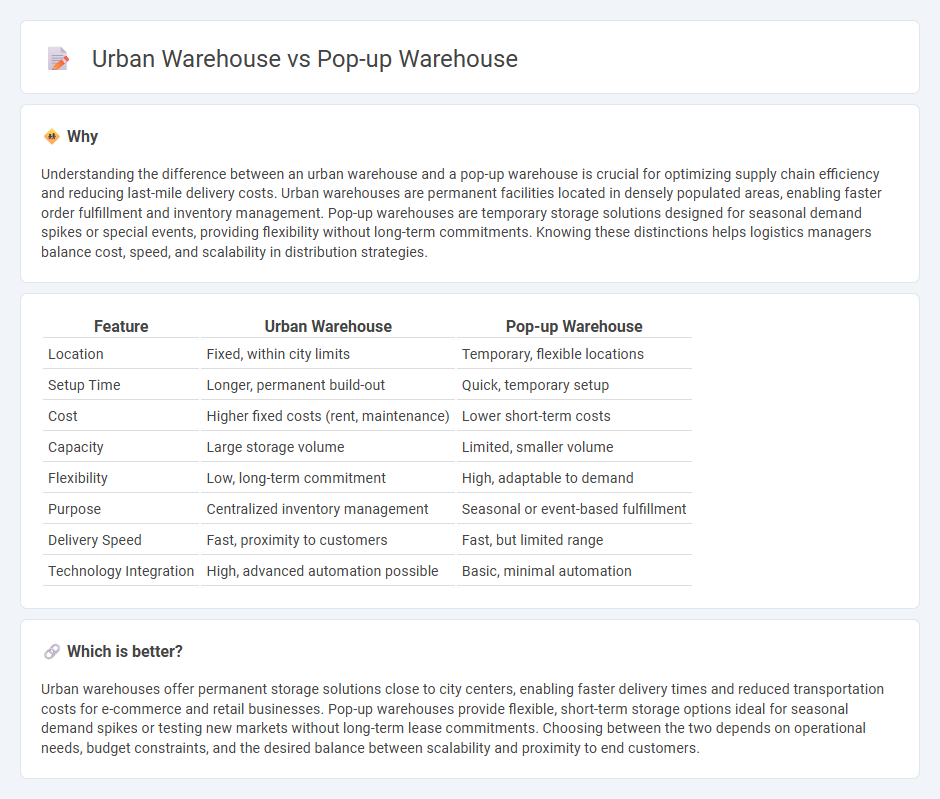
Urban warehouses offer strategic placement within city centers, enabling faster delivery times and improved last-mile logistics for e-commerce and retail businesses. Pop-up warehouses provide flexible, temporary storage solutions that adapt quickly to fluctuating demand, ideal for seasonal sales or special events without long-term commitments. Explore more to understand which warehouse model best suits your urban logistics strategy.
Why it is important
Understanding the difference between an urban warehouse and a pop-up warehouse is crucial for optimizing supply chain efficiency and reducing last-mile delivery costs. Urban warehouses are permanent facilities located in densely populated areas, enabling faster order fulfillment and inventory management. Pop-up warehouses are temporary storage solutions designed for seasonal demand spikes or special events, providing flexibility without long-term commitments. Knowing these distinctions helps logistics managers balance cost, speed, and scalability in distribution strategies.
Comparison Table
| Feature | Urban Warehouse | Pop-up Warehouse |
|---|---|---|
| Location | Fixed, within city limits | Temporary, flexible locations |
| Setup Time | Longer, permanent build-out | Quick, temporary setup |
| Cost | Higher fixed costs (rent, maintenance) | Lower short-term costs |
| Capacity | Large storage volume | Limited, smaller volume |
| Flexibility | Low, long-term commitment | High, adaptable to demand |
| Purpose | Centralized inventory management | Seasonal or event-based fulfillment |
| Delivery Speed | Fast, proximity to customers | Fast, but limited range |
| Technology Integration | High, advanced automation possible | Basic, minimal automation |
Which is better?
Urban warehouses offer permanent storage solutions close to city centers, enabling faster delivery times and reduced transportation costs for e-commerce and retail businesses. Pop-up warehouses provide flexible, short-term storage options ideal for seasonal demand spikes or testing new markets without long-term lease commitments. Choosing between the two depends on operational needs, budget constraints, and the desired balance between scalability and proximity to end customers.
Connection
Urban warehouses and pop-up warehouses both serve as strategic nodes in the logistics network to enhance last-mile delivery efficiency. Urban warehouses offer permanent storage solutions in densely populated areas, reducing transit times and transportation costs. Pop-up warehouses provide flexible, temporary storage options that adapt to fluctuating demand, complementing urban warehouses by scaling capacity during peak periods or special events.
Key Terms
Flexibility (Pop-up Warehouse)
Pop-up warehouses offer unmatched flexibility by enabling businesses to quickly establish temporary storage close to demand hotspots, adapting to seasonal peaks or sudden market shifts without long-term commitments. These agile spaces can be scaled up or down instantly, reducing overhead costs and enhancing supply chain responsiveness in urban environments. Explore how pop-up warehouses can revolutionize your logistics strategy with unparalleled flexibility.
Proximity to Consumers (Urban Warehouse)
Urban warehouses offer unparalleled proximity to consumers, significantly reducing delivery times and enhancing last-mile logistics efficiency. These facilities are strategically located within city centers or densely populated areas, facilitating quick order fulfillment and better inventory turnover. Explore more about how urban warehouses transform supply chain dynamics and customer satisfaction.
Lease Duration
Pop-up warehouses typically offer short-term lease durations ranging from a few days to several months, providing flexibility for seasonal demands or temporary storage needs. Urban warehouses often involve longer lease contracts, spanning multiple years, designed to support continuous inventory flow and faster delivery in densely populated areas. Discover how lease duration impacts your supply chain strategy and warehouse choice by exploring more insights.
Source and External Links
Pop-Up Warehousing: Definition, Risks, and Benefits - Pop-up warehousing is the temporary use of underutilized spaces to create flexible, cost-effective micro-fulfillment centers that help businesses manage seasonal demand and excess inventory efficiently by renting space only as needed without long-term commitments.
How Does Pop-Up Warehousing Work? - Innovapptive - Pop-up warehousing, also called on-demand warehousing, offers agile, scalable storage solutions that allow businesses to quickly respond to fluctuating market demands and improve delivery speeds, especially in the growing e-commerce sector.
The Warehouse Sale - Pop-Up Shoe Store - Pop-up warehouse sales can also refer to temporary retail events where brands offer large selections of products, such as shoes, at discounted prices for a limited time, leveraging temporary warehouse-like spaces to host the sales.
 dowidth.com
dowidth.com